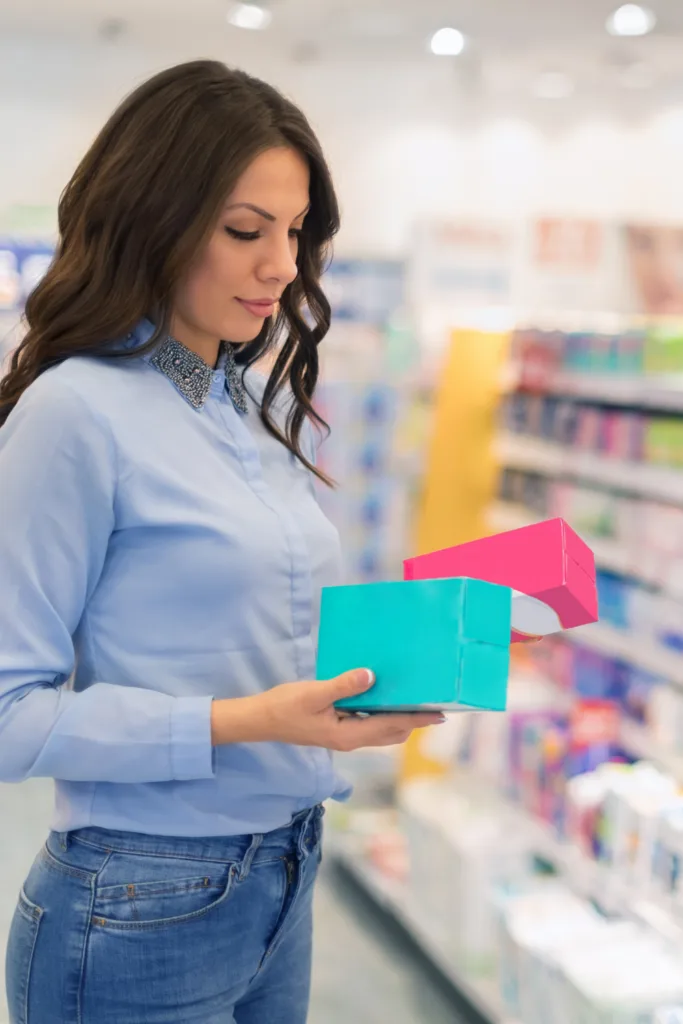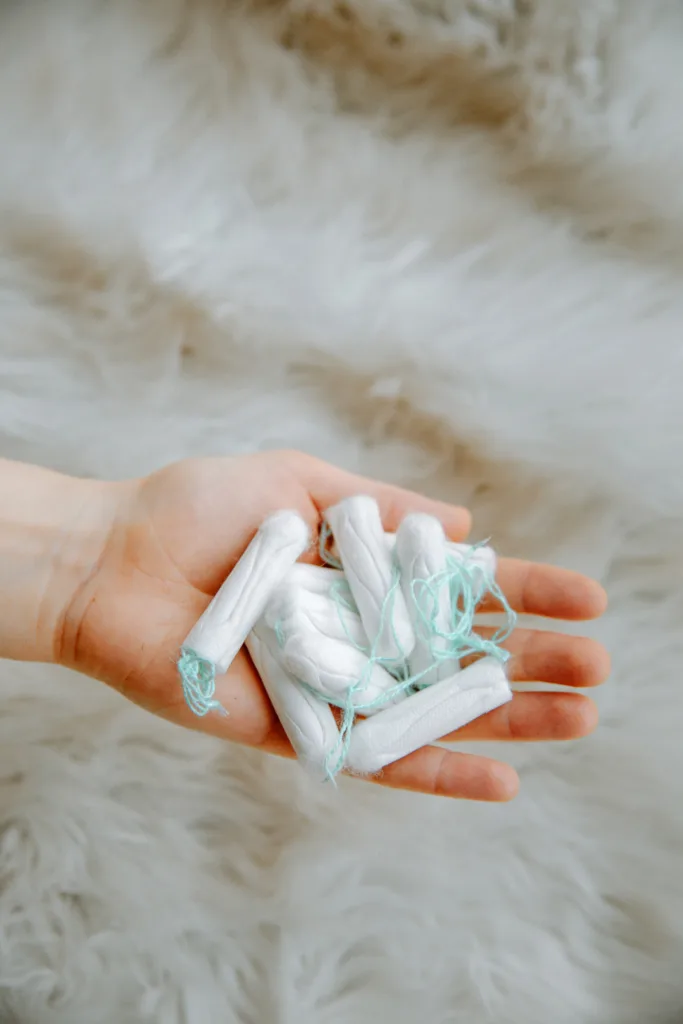Do you know what’s in your tampons and pads? Not many women do.
In fact, the FDA doesn’t regulate what goes into tampons and pads. It only regulates the absorbency for selling purposes.
Because The Food and Drug Administration doesn’t regulate the contents of these hygiene products, companies do not have to disclose what’s in them.
That’s scary! We as women deserve to know exactly what’s in our feminine hygiene products!
Both tampons and pads are considered necessity products for women. But there are other natural alternatives to tampons and pads.
With these natural alternatives you can say goodbye to toxic chemicals that may be lurking inside tampons and pads.
Disclosure: Bear in mind that some of the links in this post are affiliate links and if you click on them to make a purchase I will earn a commission. Keep in mind that I link these companies and their products because of their quality and not because of the commission I receive from your purchases. The decision is yours, and whether or not you decide to buy something is completely up to you.
The tampon and pad industry is expected to reach an all time high by 2020, reaching to a whopping $4.6 billion dollar worth.
Around the world in developing countries women are receiving more access to tampons and pads they didn’t have years before.
So how many women use tampons? About 70% of menstruating women.
If a woman uses tampons throughout her life, she will go through approximately 16,000 tampons!
With lifestyle changes and feminine hygiene awareness, the tampon and pad market is projected to profit even more.
Even though the popularity of tampons and pads is expanding around the world, health scientists are concerned. And for good reason….
What’s In Tampons & Pads?
This is the main reason for concern in the health science world. No one really knows what all is included in tampons and pads.
On many boxes, the ingredient “cotton” is printed on the box.
However, tampons and pads are more than just cotton fibers. The printed label of “cotton” on the side is a little deceiving and scientists are beginning to research its contents.
Research from Reproductive Toxicology in 2014 found feminine hygiene products contain toxic chemicals.
The harmful chemicals found include perfumes, dyes, preservatives and pesticides.
While we encounter many of these harmful chemicals in our daily lives, these chemicals in tampons are more concerning.
Since the chemicals in tampons are being placed inside the vagina, the vagina’s mucous absorbs the chemicals.
Once those chemicals are absorbed, they then travel into the bloodstream.
When it comes to tampons and pads that are scented, research suggests that an exposure to phthalates is increased.
Phthalates are a group of chemicals that are believed to be endocrine disrupters.
In other words… Phthalates have the potential to cause fertility issues.
For any women trying to conceive, this is a major problem.
Phthalates and other endocrine disruptors pose the following risks:
- Increased risk of developing cancer.
- Infertility issues including low sperm concentration and ovarian disorders.
- A negative effect on fetal brain development leading to learning disabilities, ADD and developmental delays.
- Impaired immune system that’s more susceptible to autoimmune disorders
- Increased risk of diabetes
- Early puberty
While these effects from endocrine disruptor chemicals is very alarming…
It is worth mentioning that these effects are seen years after continuous exposure.
For women who use tampons and pads, it’s estimated that they are exposed to these toxins for more than 7.5 years!

Related Articles: 9 Incredible Benefits Of Oil Pulling
The Dangers of Toxic Shock Syndrome (TSS)
As women who use tampons and pads it’s important to know what Toxic Shock Syndrome is and your risk of developing it.
Although TSS is rare, it is life-threatening. Toxic shock is the result of a staph or strep bacteria.
From the years of 1930 to 1978 there was an increase in TSS due to tampon use among women of menstruating age.
By 1981, researchers found that ultra-absorbent tampons are linked to toxic shock. Therefore, the more absorbency a tampon has, the more at risk you are of developing TSS.
Your risk of TSS is also increased the longer a tampon is not changed.
So how do you completely eliminate your exposure to toxic chemicals and your risk of Toxic Shock Syndrome?
You make the switch to a more natural alternative!
Natural Alternatives To Tampons & Pads
Menstrual Cups
I list this natural alternative first because menstrual cups are something I’ve been using for about four years.
I made the switch from tampons to menstrual cups while my husband and I were going through infertility treatment.
I ditched the tampons because I wanted to lower my exposure to harmful chemicals to increase my own fertility.
I figured… The less chemicals I encounter, the healthier I’ll be!
Menstrual cups are a natural alternative to tampons and pads with…
- No leaks
- Long-wear
- No Toxic Shock Syndrome risk
- No harmful chemicals
Since making the switch, I’ve never looked back!
You have two options when it comes to menstrual cups- Softcups and Menstrual Cups.
Softcups are disposable menstrual disks that are cleared by the FDA. You can wear them swimming, exercising and even during sex.
They have a long-wear of 12 hours and are able to hold the equivalent of 5 tampons!
They are super comfortable and eliminate odor and leaks.
A menstrual cup is a reusable cup made of silicone that forms a tight seal around the cervix to prevent leaks and odors. It can be worn for 12 hours straight!
A warning about menstrual cups: You need to be comfortable with your body! It takes a few times to properly get a menstrual cup in.
But once you get the hang of it, you’ll never what to use tampons or pads again!
Period Underwear
You’ve probably heard about these on the news lately and if you’re like me, your skeptical.
Menstrual period panties are absorbent material that can be used with or without menstrual cups, tampons and pads.
They are completely leakproof, machine washable and are meant to replace other feminine hygiene products.
Although I am still skeptical about period underwear… I have talked to other women who use them every month and find them to be a game changer for periods.
It’s all a matter of trial and error with natural period products and what you prefer.
Sea Sponges
Yes, sea sponges! An organism from the oceans. You’ll typically find these in arts and crafts stores.
I always used them for painting, but many women are actually using them as a natural alternative to tampons.
Sea sponges can be cut to a specific size to fit snuggly inside the vagina just like a tampon. They are also reusable and biodegradable.
To use sea sponges for menstrual bleeding:
- Wash the sea sponge with a natural soap
- Trim sea sponge to desired size
- Wet sponge with water
- Squeeze out excess water
- Insert into vagina
It’s that easy!
Reusable Pads
Similar to cloth diapering, reusable pads for menstrual bleeding are made of cotton, bamboo, hemp and etc.
Reusable menstrual pads are easy to use. Just place one inside your underwear and change when you need to, then throw them in the washer and reuse again.
This is a great natural alternative for women who typically use sanitary pads, but they want to make the switch away from harmful chemicals.
Related Articles: 5 Simple Ways To Naturally Fix A Hormonal Imbalance
Final Thoughts
The truth is… Research is only no beginning to study the effects tampons and pads have on women.
We really don’t know all that’s involved in the manufacturing of feminine hygiene products.
And scientists are now just researching tampons and pads. Why?
Women and menstrual cycles are still a rather taboo subject. People don’t want to talk about periods, let alone research about it.
Society would rather just put a bandage over the issue of women’s hygiene health and continue to manufacture products that may or may not be safe.
I think it’s time for women to take a stand and be in control of their feminine health.
Throw away the pads. Toss out the tampons and change your health.
By simply switching to an all natural alternative you can eliminate…
- Your exposure to chemicals
- Possible increase your fertility health
- Spend less money on tampons and pads
- Use a reusable product that’s better for the environment
So what are you waiting for? Change your feminine health and reduce your exposure to toxic chemicals from tampons and pads!
Works Cited


